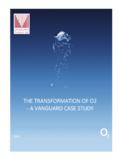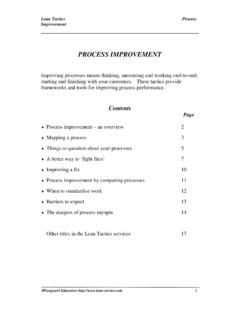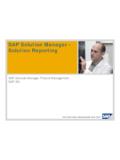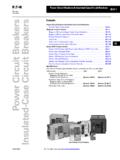Transcription of study: Improving performance in HR London Camden
1 1 case study : Improving performance in HR London Camden The London Borough of Camden is in the heart of London and employs over 5,000 people. The borough s HR directorate has a major influence on the core functions of the council, helping it to deliver excellent customer service and supporting organisational change initiatives. In July 2012 Lisa Freshwater, HR Head of Service at Camden , had been hearing great things from colleagues about the results they were getting from applying some new thinking; the Vanguard Method. Those who had adopted it were consistently delivering better service at lower costs.
2 Curious about what impact she might be able to make with it in her department she decided to take a closer look. Initially starting with just 3 days of scoping to see what potential there was, Lisa told us, it immediately became really clear that there were wasteful practices we could tackle across the whole service . She decided to introduce the Vanguard Method to her department and use it to reassess processes and then redesign an improved system and working methods. The results achieved in just the first 4 months following adoption have been impressive. Reduction of wasted capacity by 50% (10 FTE). Better service for the customer.
3 The number of queries successfully resolved for the customer at the first point of contact rose from 56% to 96%. The number of progress chasing and complaint calls (failure demand) fell from 44% to 17%. Staff are reporting better job satisfaction and higher morale. Assessing the existing system: Overview of the Camden HR Service structure: 1. General advice and Payroll: HR Direct Contact Centre. Employee Maintenance. HR Payroll. 2. Recruitment. 3. Advice and case . 4. Change management. 2 This first phase tackled the low level advice and payroll functions which were split into 3 teams. HR Direct was the first point of contact via phone, mail or e mail.
4 Employee maintenance was responsible for the data input and timesheets of the borough s 5,000 employees. The Payroll team was responsible for the accurate payment of staff salaries. Purpose: The first step in the successful transformation of any system is to understand what the true purpose of the service is from the customer perspective. In a support service like HR this raises an interesting challenge. The automatic reaction will most likely be towards an internal customer. However, we must also consider how an organisation responds to the external customer. So when we ask the question what is the purpose of the HR service in customer terms, the answer should be something like: Get me the right job, pay me, look after me and help me to do my job effectively However, the de facto purpose that existed at the front end of the system was: Move stuff out of my work queue into somebody else s In other words the front end of the system had become about managing work flows and allocation of work.
5 Demand and Capability The current capability of the system to deal with calls or e mails in one stop was poor. Only 56% of the demand was dealt with at the first point of contact. 44% was handed over to the next function and/or required to contact them again. Overall the working purpose of the system had become more about moving work around HR rather than adding value by addressing incoming demand from customers. Some distance from what the organisation, or the department heads, Going out and talking to people and finding out what their experiences are was really powerful, as was following work through HR from the beginning.
6 I think the process mapping was quite helpful in terms of what we identified and it s actually only when you pulled it all together in one process that you could realize how the system wasn t fit for purpose and was no longer adding Matt Green, HR Team Manager Waste and system conditions Most sources of waste are built in to the traditional way in which many of us have been taught to manage our services. The Vanguard Method allows us to shine a light on the root causes of waste and the assumptions that surround them. Most of the waste generating system conditions discovered in Camden s HR processes are common, not only to the rest of the council but to many offices across the western world.
7 3 Functionalisation / Specialism: The system had been designed with multiple hand overs to functionalised specialist areas. The hand overs produced a lot of waste, often creating double or rework. HR Direct itself was operating more like a post office exchange; handing over emails or phone calls rather than being able to answer queries directly in one stop and add value. Targets: The payroll team worked to a monthly deadline for payroll entry, where all queries had to be processed in order to get paid on time. But targets drive behaviours. In this case the focus on the payroll close down drove a certain way of working within the payroll team.
8 Instead of processing a change as and when it came in from the customer, the team collected the changes until a few days before payroll close down and then processed them in a large batch. The idea was that doing the payroll alterations all together before the close down was more efficient. But staff often only realised at the last minute that the information given about many changes was not sufficient for them to complete the task. As a consequence they had to chase information which often didn t get back to them in time for the deadline. This resulted in over and under payments to staff, leading to confusion and queries and a lot of time wasted on fielding those contacts and on making manual adjustments.
9 Checking: There were multiple check points when processing a pay change. Some forms were even checked 3 or 4 times. Doing this cost the service a lot of capacity. The thinking behind the policy was we need to have 100% accuracy . However, on investigating the volume of errors, the team found there were hardly any human errors. Most of the errors were predictable and one of the main causes was that the IT systems needed some adjustment. The checking affected people s behaviour as well, because the staff knew that someone would check their work, it removed their responsibility for building quality into the work.
10 Audit & Legal requirements: A big excuse for unnecessary checks, double work, or unnecessary scanning or storing of information was it was the requirement of the Internal Audit team. By stepping back and really understanding the risk of fraud in some processes or understanding the real legal requirements, the team was able to eliminate huge amounts of waste. The biggest lesson for me was the amount of waste that goes on and the lack of challenges to process, like why are you doing this, if it doesn t add People don t come forward and challenge, they just accept the status quo: we have always done it this way or we don t even know why we do that!












